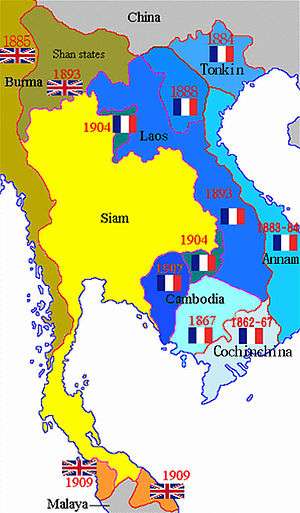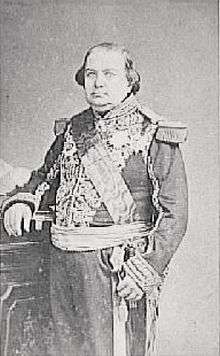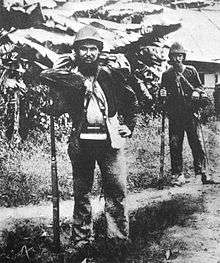Air Vietnam
| |||||||
| Founded | 1951 | ||||||
|---|---|---|---|---|---|---|---|
| Ceased operations | April 30, 1975 | ||||||
| Hubs | Tan Son Nhut International Airport | ||||||
| Secondary hubs | Da Nang International Airport | ||||||
| Fleet size | 15 | ||||||
| Destinations | 20 | ||||||
| Company slogan | The Airline with the Charming Traditions[1] | ||||||
| Parent company | Government of the State of Vietnam 1951-1955, the Republic of Vietnam 1955-1975 | ||||||
| Headquarters |
Saigon, South Vietnam | ||||||
Active from 1951 to 1975, Air Viet Nam (Air VN) (Vietnamese: Hãng Hàng không Việt Nam) was South Vietnam's first commercial air carrier, headquartered in District 1, Saigon.[2] Established under Emperor Bảo Đại, the airline flew over one million passengers, including during the Vietnam War, before its collapse due to Fall of Saigon.
History





Air Viet Nam's initial fleet consisted of five Cessna 170s, with the airline flying mainly between small towns throughout Vietnam. By 1975, Air Viet Nam started using Douglas DC-3s and Boeing 727s on both regional and international routes.
As passenger traffic increased with the start of the Vietnam War, Air Viet Nam added aircraft, initially Viscounts, DC-3s, and DC-4s. It eventually obtained more modern aircraft, including Boeing 727s, some of which were obtained from Air France and Pan Am. At least one C-46 was leased from China Airlines, and was flown by a Taiwanese crew. That aircraft had a color scheme different from the rest of the Air Viet Nam fleet.
In an unusual joint venture, Air Viet Nam was joined by Continental Air Services (CASI), a subsidiary airline of Continental Airlines set up to provide operations and airlift support in Southeast Asia, in the mid-1960s. Under this agreement, CASI would share passengers and cargo routes with Air Viet Nam on certain domestic and international routes. In addition, CASI and Air Viet Nam would share hangars and flight lines. CASI also picked up a portion of aircraft maintenance. Heavy engine overhaul was done in Hong Kong, by China Airlines, and some in Taiwan, by Air Asia (a subsidiary of Air America). CASI paid a portion of its revenues to Air Viet Nam for the routes and privileges. Many CASI aircraft operating from Saigon carried the dragon/flag roundel of Air Viet Nam.
Fall of Saigon
During the Fall of Saigon and the impending invasion of North Vietnam into South Vietnam, Air Viet Nam decided to assist and help all South Vietnamese citizens to escape to neighboring countries. Many of their pilots and crew worked long hours ferrying South Vietnamese citizens to Thailand, Taiwan, the Philippines, and other Southeast Asian countries to escape the invading North Vietnamese army.
One Air Vietnam Boeing 727 is returned to Vietnam from Hong Kong in early June 1975, by lead pilot Huynh Minh Boong, who has married General Pham Hung's sister. Captain Huynh Minh Boong with over 10,000 hours flight, was pilot on Vietnam Airlines overseas flights due to his IATA credentials, then in early 1980 he was appointed as head of training of Vietnam Airlines, now retired and lives in Ho Chi Minh City.
The only commercial jet airplanes transferred from Air Vietnam to Vietnam Airlines are: one (1) Boeing 707, and one (1) Boeing 727-100.
Destinations
According to a timetable published in 1969 Air Vietnam served these cities:
Asia
East Asia
Southeast Asia
Europe
Codeshare partners
According to the timetable published in 1962, Air Vietnam codeshared with the following airlines:[5]
.svg.png) Japan Airlines
Japan Airlines.svg.png) Cathay Pacific
Cathay Pacific Pan American World Airways
Pan American World Airways Air France
Air France British Overseas Airways Corporation
British Overseas Airways Corporation
Flight crew
Air Viet Nam flight crews were composed of civilians with a mixture of ex-military pilots, (mostly former Vietnam Air Force), along with a few Americans. However, one American CASI pilot reported that the Taiwanese crew of the leased C-46 always parked its aircraft separately at Tân Sơn Nhất International Airport in Saigon and kept its distance from the regular Air Viet Nam and CASI crews.
Uniforms
Pilots for Air Viet Nam wore a distinctive gold/bronze wing with a center shield containing a colored enamel version of the dragon/flag. It can be presumed that some senior grades of pilot and crew existed, although how these were indicated is not clear.
Stewardesses, or flight attendants, wore a gold or bronze metal wing with embossed/relief dragon/flag roundel. Uniforms consisted of the traditional áo dàis in a variety of colors.
Aircraft livery
Air Vietnam aircraft generally had a single or dual green stripe down the main fuselage. The top fuselage was generally white with a natural metal (silver) lower. The colorful dragon/flag roundel appeared in various sizes, most often on the tail rudder. Sometimes the roundel would appear alone and occasionally with a dual green stripe. The wording "Air Viet Nam" appeared in red/orange lettering above the windows on all large aircraft except the 727s, which were marked "Hang Không Viet Nam". Exceptions to these schemes included the early Viscount aircraft, which were all white with a green stripe and had the roundel appearing on the front fuselage. The Chinese C-46 aircraft had a blue and red nose-side stripe with the roundel appearing on the rudder.
Marketing
Advertisements used from the mid-1960s included South Vietnamese Olympians, such as Thach Thi Ngoc, and flamboyant military officer Nguyễn Cao Kỳ, whose wife Madame Nguyễn Cao Kỳ was a flight stewardess before they were married. These celebrities promoted the airline's operation of Viscounts on the "Green Dragon Route", alternating flights from Saigon to Siem Reap, Cambodia; Bangkok, Thailand; and Hong Kong. Timetables indicate domestic routes covering destinations as far north as Huế, as far south as Cà Mau, and including almost every major city in between.
Incidents and accidents
- 16 August 1954
- Bristol Freighter 21E F-VNAI crashed into the Mekong River while on approach to Pakse for an emergency landing due to engine problems, killing 47 of 55 on board. The aircraft was operating a flight from Hanoi to Tan Son Nhut International Airport.[6]
- 20 November 1962
- Douglas C-47B XV-NID crashed into a mountain 19.6 km (12.2 mi) northwest of Da Nang Airport due to a navigation error in bad weather, killing all 27 on board. The aircraft was operating on a flight route from Phu Bai Airport to Da Nang Airport.[7]
- 16 September 1965
- Douglas C-47A XV-NIC was shot down by Communist ground fire shortly after takeoff and crashed 11 km (6.8 mi) northeast of Quang Ngai, killing all 39 on board; one passenger survived, but died later.[8]
- 2 April 1969
- Douglas DC-6B XV-NUC was destroyed on the ground at Hue-Citadel Airfield during a Communist attack.[9]
- 1 May 1969
- Douglas C-54B F-BELL burned out on the ground while parked at Saigon Airport.[10]
- 20 September 1969
- Douglas C-54D XV-NUG collided with a US Air Force McDonnell Douglas F-4 Phantom II and crashed into a field, killing 74 of 75 on board and two people working in the field. The aircraft was operating on a flight route from Pleiku Airport to Da Nang Airport.[11]
- 22 December 1969
- Douglas DC-6B B-2005 suffered an explosion and hydraulic failure while descending for Nha Trang Airport. After a low level pass to check the landing gear, a nose-high flapless approach was made. The aircraft touched down, but became airborne again after application of reverse thrust. The throttles were closed and the aircraft landed again, but overran the runway, struck a concrete pylon and caught fire, killing 10 of 77 on board and 24 on the ground.[12]
- 22 July 1970
- A U.S. Army private, George M. Hardin, hijacked a DC-4 en route from Pleiku to Saigon. Hardin allowed the 65 passengers aboard to disembark from the plane before moving to the cockpit and threatening the pilot with a small knife. He was detained in Saigon after attempting to force the pilot, Floyd R. Derieux, to take him to Hong Kong, but the pilot told him the DC-4 could not carry enough fuel to make the trip. There were no fatalities.[13]
- 30 September 1970
- Douglas DC-3DST-318A B-305 crashed into a hill in the Hai Van Mountains at 970 m (3,180 ft) near Da Nang while attempting to divert to Da Nang Airport due to weather conditions at its intended destination of Phu Bai Airport, Huế. Three of the 38 people on board were killed.[14]
- 1 November 1970
- Curtiss C-46 B-1543 force-landed on a beach at Qui Nhon; the aircraft sank in sand and flooded out at high tide. Ther aircraft was operating on a flight from Saigon to Quang Ngai.[15]
- 22 August 1971
- Douglas DC-3A-375 B-304 was written off at Kampot Airport.[16]
- 24 September 1972
- Douglas C-54D XV-NUH crashed into a marshy area 23 miles from Saigon, killing 10 of 13 on board. The aircraft was operating a flight from Vientiane Airport to Tan Son Nhat International Airport.[17]
- 19 March 1973
- Douglas C-54D XV-NUI crashed 4.1 mi S of Buon Ma Thuot Airport after an explosion in the cargo hold near the wing spar, killing all 58 on board. The aircraft was operating a flight from Tan Son Nhat International Airport to Buon Ma Thuot Airport.[18]
- 5 September 1973
- Boeing 727-121C XV-NJC suffered an explosion in the galley at 15,000 ft (4,600 m) 15 minutes after takeoff from Bangkok, injuring two passengers and a stewardess; the aircraft was able to return and land safely at Bangkok. Although it was thought that a bomb exploded, a Royal Thai Air Force investigation concluded that a defective broiler in the galley caused the explosion. Although the aircraft was repaired and returned to service, it was written off following the hijacking and crash of Flight 706 in 1974.[19]
- 17 November 1973
- Douglas C-47B XV-NIE struck a mountain at 400 m (1,300 ft) 20 kilometres (12 mi) NNW of Quảng Ngãi killing all 27 people on board. The crew had gotten lost and flew too low in a mountainous area while attempting to reach Chu Lai, near the crash site. The aircraft was operating a domestic scheduled passenger flight from Tan Son Nhat International Airport to Quảng Ngãi Airport.[20]
- 20 February 1974
- Douglas C-54A XV-NUM was hijacked en route from Qui Nhon to Da Nang. The hijacker was a 19-year-old South Vietnamese man demanding to go to Dong Hoi, North Vietnam. When the aircraft landed at Huế, the hijacker realized he had been tricked and detonated a grenade, killing himself and two police officers. The explosion also blew a 2 x 3 m hole in the port side of the fuselage and broke three starboard side windows. The aircraft was written off.[21]
- 15 September 1974
- Air Vietnam Flight 706 - Le Duc Tan, a ranger in the South Vietnamese army who had recently been demoted from captain to lieutenant for the theft of two cars in Da Nang, smooth-talked his way past security checkpoints and hijacked the Boeing 727 en route from Da Nang to Saigon, demanding to go to Hanoi. He detonated two hand grenades, and the aircraft crashed at Phan Rang when it overshot the runway on an attempted landing. All 75 persons on board, including 67 passengers and eight crew members, were killed.
- 12 March 1975
- Douglas C-54D XV-NUJ crashed 16 mi from Pleiku, killing all 26 on board; the wreckage was not examined due to hostile conditions in the area.[22]
See also
References
- ↑ Air Vietnam Services
- ↑ "World Airline Directory." Flight International. 10 April 1969. 557. "Head Office: 116 Boulevard Nguyen-Hue. Saigon. South Vietnam."
- ↑ Air Vietnam Route Map
- ↑ Air Vietnam Time Table
- ↑ Air Vietnam Timetable
- ↑ Accident description for F-VNAI at the Aviation Safety Network. Retrieved on 5 September 2011.
- ↑ Accident description for XV-NID at the Aviation Safety Network. Retrieved on 22 November 2016.
- ↑ Criminal description for XV-NIC at the Aviation Safety Network. Retrieved on 22 November 2016.
- ↑ Criminal description for XV-NIC at the Aviation Safety Network. Retrieved on 22 November 2016.
- ↑ Hull-loss description for F-BELL at the Aviation Safety Network. Retrieved on 22 November 2016.
- ↑ Accident description for XV-NUG at the Aviation Safety Network. Retrieved on 11 March 2011.
- ↑ Accident description for B-2005 at the Aviation Safety Network. Retrieved on 5 September 2011.
- ↑ Hijacking description at the Aviation Safety Network. Retrieved on 22 November 2016.
- ↑ Accident description for B-305 at the Aviation Safety Network. Retrieved on 20 October 2010.
- ↑ Accident description for B-1543 at the Aviation Safety Network. Retrieved on 22 November 2016.
- ↑ Hull-loss description for B-304 at the Aviation Safety Network. Retrieved on 22 November 2016.
- ↑ Accident description for XV-NUH at the Aviation Safety Network. Retrieved on 22 November 2016.
- ↑ Criminal description for XV-NUI at the Aviation Safety Network. Retrieved on 22 November 2016.
- ↑ Non hull-loss description for XV-NJC at the Aviation Safety Network. Retrieved on 24 October 2016.
- ↑ Accident description for XV-NIE at the Aviation Safety Network. Retrieved on 22 November 2016.
- ↑ Hijacking description for XV-NUM at the Aviation Safety Network. Retrieved on 22 November 2016.
- ↑ Accident description for XV-NUJ at the Aviation Safety Network. Retrieved on 2 April 2014.
External links
![]() Media related to Air Vietnam at Wikimedia Commons
Media related to Air Vietnam at Wikimedia Commons


